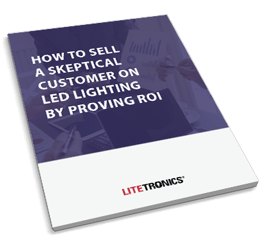 After lumens, contractors and customers’ next questions are often “What is the rated life?” and “How long is the warranty?” That’s because they know how heavily ROI—and the green light on the project—depend on those two variables.
After lumens, contractors and customers’ next questions are often “What is the rated life?” and “How long is the warranty?” That’s because they know how heavily ROI—and the green light on the project—depend on those two variables.
Let’s explore the ins and outs of LED rated life and warranties, so you can offer your customers both expertise and increased value.
Rated Life Vs. Product Warranties: The 101
Both rated life and product warranties are central to determining the ROI of the lighting project. Why? Because the longer the life span of the LED, the less time and money needed on replacing it. And the longer the warranty, the more protection the customer has from the cost of a replacement.
 Rated Life 101
Rated Life 101
Rated life is the amount of time a piece of equipment is expected to last, before significant light output diminishes, with normal use per the manufacturer.
Sounds straightforward, but let’s break down some of those terms.
- The rated life of an LED luminaire is measured in hours and translates into how long the user can expect that fixture to reliably produce light.
- In light bulbs, Average Rated Life (ARL) is measured by how long it takes for half the light bulbs in a test batch to fail. A bulb with an ARL of 1,000 hours means in a test of 100 bulbs, 50 died when the test time reached 1000 hours. Most LEDs have an ARL of 50,000 hours. (BTW, Litetronics LEDs have an ARL of 100,000 hours.)
- Light output is the luminous flux (measured in lumens) emitted by a lamp or luminaire. If the light output at installation is 100%, then the output is usually said to be significantly diminished when there is a 30% decrease in output for general lighting, and 50% decrease for decorative lighting. That’s referred to as the LEDs useful life.
- The manufacturer will define the conditions that correspond to normal use, but in general, ARL tests are conducted in conditions that one would reasonably expect in customer applications. A bulb used in an area that is unusually hot or cold, exposed to wet or hazardous materials, or near vibrating machinery or any other “abnormal” situation, may not reach the ARL.
How the LED light is used has an impact, too. Turning a bulb on and off frequently will reduce the ARL, for example. Now, LED bulbs are less affected by on/off cycles than older fixtures like fluorescents, compact fluorescent and HID bulbs, but in general, you can expect the ARL for a bulb that is turned on and off once a day to be much longer than one that is cycled many times a day.
The bottom line? There are always caveats to any broad statement like Average Rated Life, so understanding how and where an LED will be used and installed will tell you how “average” of a rated life you and the customer should expect.
 Warranties 101
Warranties 101
A manufacturer’s warranty is a guarantee that a product will perform and the terms and situations where repairs or exchanges will be made if the product doesn’t work as originally described or intended.
Are LED warranties an iron-clad guarantee a customer will never lose money on a product?
No, because most warranties are conditional and not full.
As we’ve described above, there are plenty of situations in how an LED light is installed or used that may interfere with the performance of the light … and that have nothing to do with how it was manufactured. In fact, most manufacturers will want to see the product in situ to ensure that it was properly installed and that there wasn’t some other contributing factor to product failure before they honor the warranty.
(That’s another reason why you want LED lights that are designed to be easy to install, so a ham-handed installer doesn’t end up voiding a customer’s warranty!)
As a result of all these possible conditions, warranty language is usually long, intricate, and can be difficult to understand. Other than “Always read the fine print,” here are a few words to the wise about LED light manufacturer’s warranties:
The average LED lighting warranty is between 3-5 years
The term of a warranty does not necessarily reflect on the quality of the fixture. Instead, it typically reflects the period of time where a manufacturing defect is most likely to show up, and is a grace period where the manufacturer recognizes their responsibility to repair or replace the product (keep in mind labor costs are not covered by most LED light warranties.)
A high-quality manufacturer will want to ensure they learn about any defects so they can correct the issue. (If you’re wondering how committed we are to perfecting our products, most Litetronics products come with double the standard five-year warranty. If something goes wrong in Year 9, we want to hear about it and make it right.)
Many longer LED warranties include a limit on the hours of use
We talked about normal use above in rated life. Warranties have a similar concept. The term of the warranty is based on the expectation that the fixture won’t be on 24/7 year-round from the moment it is installed. Longer warranties include a limit on hours of use, either by total usage or annual usage.
Most manufacturers honor their warranty in years, not ARL
LEDs don’t come with built in alarms that ding when the rated hours are up. Warranties run from purchase date. In fact, manufacturers will usually honor the date of the warranty, regardless of the hours the bulb was in use.
Subpar electronic drivers are usually the cause of lighting failure in the first 2-3 years
The LED driver that provides electric current to the LED system is similar to a ballast for a fluorescent or HID. You’ll want to be sure the driver has a higher output power than your LEDs. If the output is equivalent to the LED power requirements, it’s running at full power and that can shorten the driver’s life span.
Which Is More Important for LEDs: Rated Life or Warranty?
It’s an answer we hate giving, but … it depends.
Essentially, you need to know how your customer uses their lighting, and how much run time they expect each year. If the rated life is 100,000 hours, and the warranty is only three years, the warranty will expire long before the fixture even approaches its Average Rated Life.
Does that mean you should ignore the life-hour rating and just look for the longest warranty?
That … also depends.
Replacing an LED light at the end of its life in a standard office setup is one thing. Having to roll out the lift and replace multiple high bay lights in a 50-foot warehouse is another. It’s not something you want to have to do any more frequently than is absolutely necessary. Customers are attracted to LEDs for trouble-free, long life, and you should choose products accordingly.
At Litetronics, we’ve saved customers from that dilemma. The majority of our LEDs come with a 10-year warranty for 100,000 hours of rated life, so customers will enjoy a good long life from the bulb and its warranty.
As you select products for your next LED upgrade project, be sure to make the customer aware of the choices you made on their behalf in regard to ARL and warranties, and how those choices will contribute to their ROI.
Looking for more ways to make your case for ROI? Be sure to check out our e-book, How to Sell a Skeptical Customer on LED by Proving ROI for more! You can download it instantly, here.



